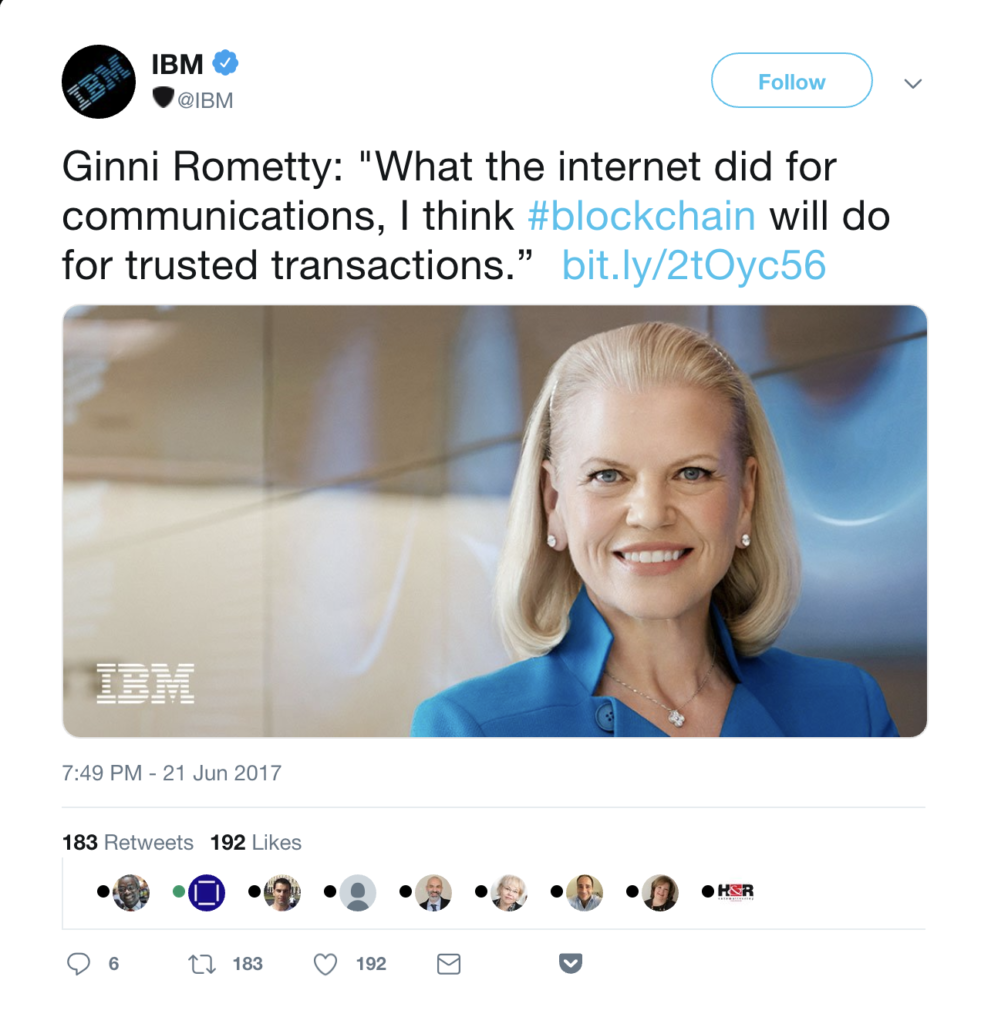
For this week’s episode, we spoke to Sandip Patel, Global Managing Director for insurance across IBM. Sandip refers to himself as a lifetime practitioner in the insurance industry having worked for PWC and Aetna and IBM within the insurance industry. In this special episode Sandip shares with us what are IBM’s 2019 insurance predictions.
What is blockchain in under 2 minutes?
Sandip reminds us that practitioners in the insurance industry are painfully aware of the friction and the manual cycles that are involved in different insurance processes.
Blockchain is an operating system for establishing trust in the insurance trust. A shared replicated and permissioned ledger technology which allows any participant in the business network and the business process, that they are engaged in across different parties, to see these systems of records. It’s a single system of records, ledger of transactions, with consensus, prominence, immutability and finality.
Blockchain carries the following three characteristics:
- A level of transparency where transactions can be inspected by the relevant parties who have been granted explicit permission to view them.
- A distributed ledger where there is a single immutable prominence regarding where the data came from and where they were actioned. This provides a level trust through every transaction flow through the blockchain.
- A level of audit trail that exists where previous transactions can be confirmed as having happened providing a level of trust in the entirety of the transaction.
IBM’s 2019 Predictions
Sandip detailed out IBM’s 2019 insurance predictions around three key points:
- Data
- New Digital Ecosystems
- Customer and ecosystem interactions to create a differentiated brand
Data
Digital transformation in insurance: Data is the new natural resource
There is a fundamental shift in how we think of data. Where data is becoming the new natural resource, particularly in insurance from a few perspective:
- Volume of data: The nature of data is changing. The rate and pace at which data sets are evolving is growing exponentially. Data sets are going to keep growing to petabytes level and more with which the insurance industry is going to have to deal with.
- Type of data: The nature of data both structured and unstructured is fundamentally changing. 60 – 70% of the data sets such as from wearables, sensors, and drones, often referred to as unstructured data sets since most computers haven’t yet been exposed to such type of data sets.
- Temporal factor of data (relevance). There are data sets which are being created which loose relevance within a few nanoseconds of being created.
The shift requires insurers to fundamentally rethink how to think about data. Traditionally insurers have thrived and excelled in capturing, storing and owning large volumes of data about their customers, products, risk factors, historical events…etc. In the future there are going to be very relevant data sets such as sensor data which informs certain risk factors at the point of time they are created where the paradigm of data is going to be how quickly are you able to capture the data set at the point of creation and enable some decision making based on certain risk factors.
Competitive advantage in the insurance industry today is defined by an insurer’s ability to leverage all this data – structured, unstructured, owned, bought, rented, accessed on demand – and drive insights at scale to proactively find new customer segments, gain early insights into customer needs, and quickly innovate products that blend traditional risk products with insightful risk advice and preventive services.
New digital ecosystems
The second paradigm shift that is happening in the insurance industry is around the new ecosystems that are being created. These ecosystems require the players within them to operate in a fundamentally different manner with their customers and partners to identify revenue and profit goals within those ecosystems.
Customer and ecosystem interactions to create a differentiated brand
In a digital world customers expect insurers to interact with them directly. This of course can be challenging to the insurance industry which is traditionally accustomed to having intermediaries. However, this digital world requires a fundamentally different mindset on how you structure those points of interaction. These points of interaction represent an opportunity for insurers to create a brand about themselves that is different to the one they traditionally played where their only point of interaction was around paying claims when something bad happened.
The ability for insurers to rethink their brand through hyper personalisation, demonstrating an element of service that is at par with other digital interactions a customer has with other companies. Create a level of perception that an insurance company isn’t here to simply pay out claims but is here to proactively pre-empt those claims and help to protect a level of trust with them.
In a data-rich environment, a segment of the insurance business will shift from pricing and managing the risk of loss to pricing and managing the risk of prevention, including monitoring and preventative services that will define competitive parity.
You now have the ability through data sets and through ecosystem partnerships to actually offer new products advice, and services where you start to change your brand to customers. Someone that is able to partner with customers to help them prevent losses before they actually happen.
Challenges of the insurance industry in realising those predictions
Whilst data has been booming in the last few years producing more data that has ever been produced, the manner in which the insurance industry uses data to price and analyse risk is based on historical data. The insurance industry doesn’t seem to have embraced real time data for real time pricing and even less for predictive analytics for anticipating future risks.
Traditionally the insurance industry has been about capturing data, storing it and analysing historical data. That approach though is going to be too costly for a single insurer to capture, store, and analyse all those data sets, even for historical purposes. Insurers are looking for partners, such as IBM, that can curate large volumes of data and make it available in a consolidated form at the point of decision making to take advantage of driving predictable models to prevent risks or to create a whole new breed of products.
In a world that is increasingly connected with autonomous cars, connected homes, and individuals with wearables we will start to look at insurance models where the technology and capability will exist to both create predictive models for how you price and manage risk. Additionally we will see new insurance products that can be both dynamically priced and managed based on how you can predict certain risks and proactively prevent them and monitor them.
German Insurance Association
To provide more detail to the above, Sandip provided us with an example regarding the importance of coopetition and the creation of non-traditional ecosystems through partnerships within the industry. IBM is doing some work with the German Insurance Association and Bosch that produces sensor devices that can be plugged into the cars. Working with Bosch and the German Insurance Association they have created a service called Ecall4all. The German Insurance Association requires its participating insurance companies to offer this device to their car insurance customers. If there is an impact to the car that the sensor detects it sends out an alert that is monitored and analysed by IBM. IBM will then send an alert, based on the GPS location of the car, for roadside assistance.
Blockchain
Blockchain will become a fundamental part of the core operating processes. IBM’s chairman, Ginni Rometty “What the internet did for communications, I think blockchain will do for trusted transactions” (read more about her view on Business insider)
The initial uptake of blockchain in the insurance industry has been around processes with high level of complexity and manual intervention that need to be automated. Additionally blockchain is useful where you have multiple parties across multiple geographies where it is impossible to know something happened with a level of trust and of provenance. That is where we have seen blockchain begin to become relevant because there is an immediate ROI benefit by simply taking the manual friction, compliance and regulatory issues out of the equation.
However as insurers start to increasingly invest into blockchain they start to realise that it can help them re-establish the provenance, transparency and trust that is needed within the industry and our ecosystem partners.
Your Turn
Sandip has provided some excellent predictions on the challenges and opportunities the insurance industry will face in 2019.
If you liked this episode, please do review it on iTunes – your reviews make a huge difference. If you have any comments or suggestions on how we could improve, please don’t hesitate to add a comment below. If you’d like to ask Sandip a question, feel free to add a comment below and we’ll get him over to our site to answer your questions.








What are the risks of NoT being in Cloud?